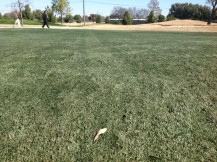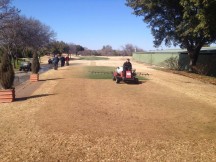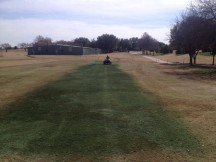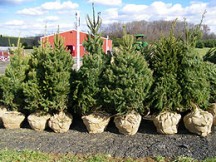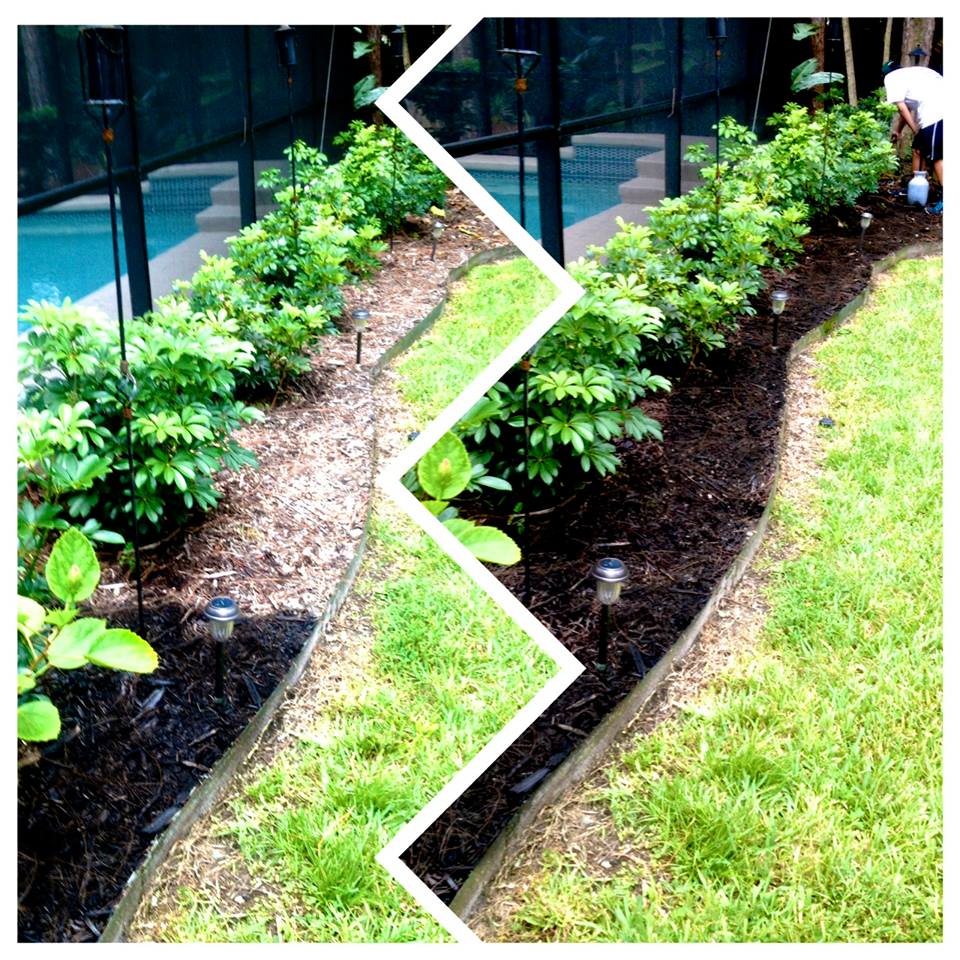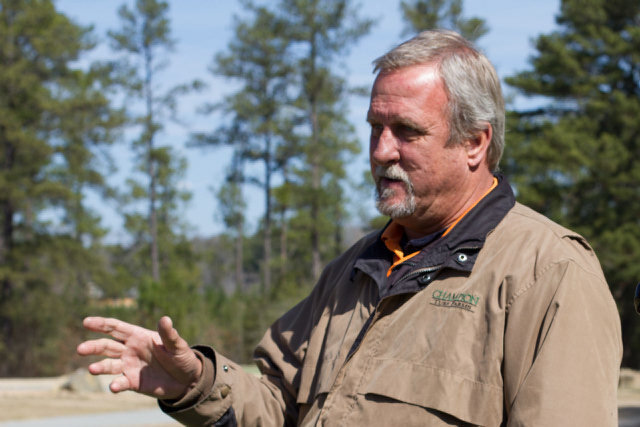Endurant turf colorant and turf paints are highlighted in a story published in the Brunswick Beacon. Read the full story here.
Welcome to the world of colorants.
Spraying the golf course with green pigments in the fall is the latest big deal in golf course maintenance. It’s good for the environment, it’s great for the golf course and helps keep golf affordable.
I went to Brunswick Plantation and spoke with Rob Vaughn, the golf course superintendent and nationally recognized guru of colorants. I watched as they “painted” the course and was amazed to see brown fairways change into a beautiful shade of green right before my eyes.
“For years, golf courses in our area overseeded with rye grass each fall,” Vaughn said.
“Golfers want to play on green grass. Unfortunately, our southern Bermudagrass goes dormant during the winter months and turns brown. Courses that overseeded and were green during the winter got more play, and soon everyone was putting down rye grass seed in the fall.
Problems with overseed
“The problems with this were many. To grow the seed, we had to water excessively each fall and that made the fairways soft and mushy. There was no roll to the ball. It was often plugged or covered in mud. Golfers were forced to play cart-path-only rules.
“In the spring, as the Bermudagrass woke up, it competed with the dying rye grass and we had patchy conditions for weeks. Basically, conditions were not great during the spring and fall, the best seasons to play golf in this area.”
Players love colorant, turf health benefits
Shawn Hicken is the head golf professional at Brunswick Plantation. He is delighted with the response to colorizing the fairways and greens.
“Our players love it,” he said. “The ball goes farther and that’s good in the winter, when you’re wearing extra clothing. The greens are fast and that’s always a plus. The fairways are green and the rough is brown, so the definition of each hole is excellent. There are no negatives.”
As I watched the sprayer move across the fairway, leaving a swath of green in its wake, Vaughn explained that colorants are good for the grass. They are made of natural pigments that bond to the grass and keep it warmer and protected during the winter months.
“I’ve taken temperature readings of turf that’s been sprayed and unsprayed turf. The grass that has been
colorized is always warmer,” he said. “The spray-on colorants protect the grass, plus we add iron to it and that is absorbed during the winter months. Because of colorants, we are cutting our Bermudagrass much earlier in the spring.”
Colorants save thousands of dollars
Vaughn has been a pioneer in the use of colorants since he first began using them on his greens in 2007. At that time, the economy was down and so were rounds of golf. He knew if he could color his fairways as well as the greens, he could eliminate the cost of the seed and save on water, fertilizers, weed killers and other chemicals.
Since dormant grass does not need to be cut, savings on labor costs would be enormous.
The next year Vaughn tried various components on the one nine and came up with a combination that worked. The grass was green and stayed green all winter long. Previously, colorants had turned blue after a few weeks, something neither superintendents nor the golfing public wanted.
Today, all 27 holes at Brunswick Plantation are sprayed with colorants and Vaughn estimates he saves nearly $75,000 a year with better results for golfers and his turf.
Vaughn likes to share his knowledge and his stories with other superintendents.
Several years ago, one fellow superintendent complimented Vaughn on his rye grass and was incredulous when Rob laughed and said it was paint.
“The guy had to walk over and look at the turf closely to see that it was colorized Bermudagrass,” Vaughn laughs.
In the last few years, Vaughn has become a leader in the movement to colorize golf courses. He has worked with the Dr. Grady Miller, agronomy professor at N.C. State University, and with Patrick O’Brien, agronomist for the Southeastern Region of the United States Golf Association (USGA).
Representatives from Pinehurst No.2 came down several times to inspect Vaughn’s work. Last year, Pinehurst No. 2 was colorized and it was done again this fall. Next year, both the men’s U.S. Open and the women’s U.S. Open will take place there. They want optimum conditions for the two events and coloring the golf course will help them attain that. The men’s Open is June 12-15; the women’s Open is June 19-22.
Special maintenance issues arise when a golf course is colorized instead of overseeded.
“Cups cannot be moved around as much, because they will not heal,” Vaughn said. “The greens are faster, so we must be careful about where those pin placements are. If a green is rolling at a 12 on the stimpmeter (a device that measures the speed of putts on greens), you cannot put the pin on a slope or the bottom of a mound.”
Some courses that are using colorants on greens and fairways are still overseeding their tees. If a course has small tees that are well used, divots will not heal as quickly, so it might be better to overseed those areas with ryegrass.
“We also try to remember that the paint is only as good as the canvas,” Vaughn said. “We want our grass thick and healthy before we apply the colorants. We usually do a light application of colorants in the fall and then the heavier stuff in December. With no competing ryegrass, the Bermuda is ready to perk up and start growing at the end of February.”
Last week, I drove down to the Myrtle Beach Convention Center, where the Carolina Section of the Golf Course Superintendents Association was holding its annual conference and trade show.
Benefits of organic Endurant turf colorant
I spoke with Jennifer Seevers of Geoponics, the company that produces Endurant Organic Colorants. Vaughn and Seevers have worked together to produce a natural looking shade, testing various pigments on Brunswick Plantation fairways over the past few years. Endurant is the product that is sprayed on the fairways and greens there.
“This my passion,” Seevers said. “It doesn’t feel like work, although I travel all over the country. Our colorants are sold in five international locations and we’re waiting for a contract with Australia.
“Colorants have become huge in our western states because of the water restrictions there. Water tables have been dropping in places like California, Arizona and Nevada. Some courses are paying $l million a year for water. If they can green up those courses during the winter months by using colorants, the price of golf course maintenance goes down, the cost of membership goes down, the cost of a round of golf goes down. It’s a boon for everyone.”
Colorants in the NFL
Check out the playing field when you watch college or NFL football next weekend. In most cases, that grass has been colorized. The same with baseball diamonds next spring. The colorants make the grass brilliant for the TV cameras.
I imagine this movement growing. In the future I might buy colorants at my local hardware store and spray them on my lawn each fall. Perfectly green grass all winter with no mowing.
Now there’s an idea whose time has come.
Full story here.
